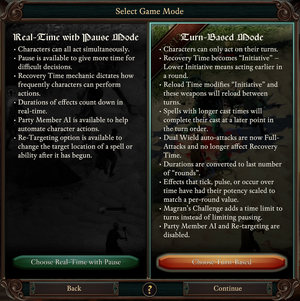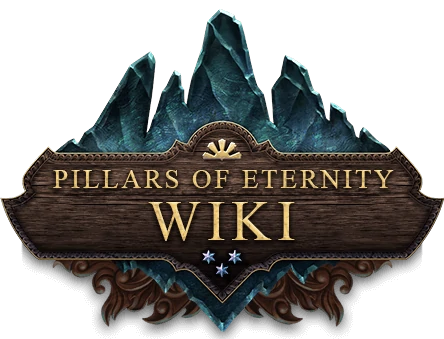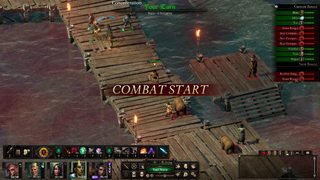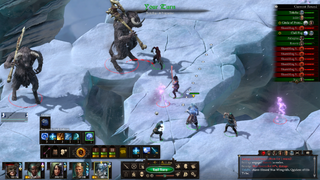
A summary of turn-based combat in game
Turn-based mode is an alternate mode of combat in Pillars of Eternity II: Deadfire. It reworks the games existing combat mechanics to function in a turn-based style of play (like that of Divinity: Original Sin, for example) instead of one that is real-time as the game is more traditionally known. This changes the approach and pacing of combat to be more slow, tactical, and deliberate, drastically affecting how the game is played. It aims to provide players with the choice of an alternate combat style for those who may prefer it.
Once starting a new game, the player is free to pick between the traditional "Real-Time with Pause Mode", and the new "Turn-Based Mode". As it changes the game fundamentally, players cannot freely swap between the two modes during gameplay (without using the console).
History[ | ]
The mode was temporarily made available to players in late December 2018 [1], though it was revealed that this was unintentional, and it was removed in a hotfix some hours later.
On the 24th of January 2019, in patch 4.1 (update #60)[2], Obsidian released a beta version of turn based mode, allowing players to give feedback and report bugs with the new system before its full release. It was rumored that the addition of this combat mode was to coincide with the release of the console versions of Pillars of Eternity II: Deadfire, in order to make the combat more accessible – given Pillars of Eternity's combat has traditionally favored the use of keyboard and mouse.
As of patch 5.0 (released on the 8th of May, 2019), turn-based mode is no longer considered to be "in beta". The patch added a variety of fixes and changes as a result of feedback from testers.
Summary[ | ]
Instead of all characters being free to take actions simultaneously, turn-based combat restricts the focus to one character at a time. Combat is taken in turn, with all combatants taking one turn each round. The combatants are queued based on their Recovery Time - now called "Initiative". Lower Initiative means acting earlier in the round, higher means acting later. Characters can only act (i.e. move, attack, and cast spells and abilities) during their turns. Once a character has taken their turn, the next character in the queue gets to move, and so on.
While the update doesn't change a lot of the actual health and damage mechanics of the game, it does change the effect of durations and over-time effects, converting them to last a number of rounds. This includes the regular tick, pulse and over-time effects, but also spell cast times and reloading. Generally, one round is equivalent to six seconds in real time, though some exceptions have been made for balance reasons.
The following is the comparison shown to the player starting a new game:
| Real-Time with Pause Mode | Turn-Based Mode |
|---|---|
|
|
Mechanics[ | ]
Action types[ | ]
 Standard action: Standard actions are the most common type of action. A Standard action uses the character's action point for the turn and happens right away.
Standard action: Standard actions are the most common type of action. A Standard action uses the character's action point for the turn and happens right away. Cast action: a Cast action uses the character's action point. The character will immediately begin casting the ability. They will finish casting the ability later in the same round.
Cast action: a Cast action uses the character's action point. The character will immediately begin casting the ability. They will finish casting the ability later in the same round. Free action: a Free action does not use a character's action point. A character can perform any number of Free actions on their turn in addition to a Standard or Cast action.
Free action: a Free action does not use a character's action point. A character can perform any number of Free actions on their turn in addition to a Standard or Cast action.
In order of precedence:
All abilities with an attacking component, a looping cast animation, and a cast time greater than 0 seconds are cast actions (generally this covers most offensive wizard/druid/priest spells).
Abilities that do not have an attacking component (including self-targeting abilities and modals), or those that have an attacking component but recover instantly are free actions.
Everything else (including use of consumables, switching weapons, placing traps, and general abilities) is a standard action. The action type of an attacking ability can be overridden, so these rules may not always apply.
Initiative[ | ]
Initiative is used to determine who will act first in the turn order. Characters with lower Initiative values will act before other characters and will complete spell casts faster.
Initiative (![]() ) influences turn order, and is directly translated from recovery time. All characters start with a base of 6 Initiative, which receives the exact same modifiers as recovery time, including the Dexterity score (at ±6% every point below or above 10, respectively), and the recovery time rating of the character's equipped armor.
) influences turn order, and is directly translated from recovery time. All characters start with a base of 6 Initiative, which receives the exact same modifiers as recovery time, including the Dexterity score (at ±6% every point below or above 10, respectively), and the recovery time rating of the character's equipped armor.
When a character attacks or casts an ability, the recovery time of the weapon or ability is added to the character's initiative for the next round, changing their turn order (though it is not cumulative).
Likewise, the cast speed for cast actions is added to the character's current initiative to determine when the cast finishes (the cast gets its own turn). If the initiative is higher than that of the last turn in the current round, it is shifted to the next round.
The attack speed of weapons is effectively ignored, as weapon attacks occur on the same turn.
Available movement[ | ]
All characters start their turn with 3 seconds of free movement, which is multiplied by their Stride to determine the total movement distance available for the turn. All party members have a base run speed of 4, though creatures have varied speeds. For example, character with +20% Stride gets 12.2m of available movement.
Other terms[ | ]
- Action (
 ): All characters get one available action per round. This may be spent performing an attack, a standard action, or a cast action - in which case the action will be "spent" later. There is no way to get more than one action per turn, nor is there a way to regenerate a spent action during the round.
): All characters get one available action per round. This may be spent performing an attack, a standard action, or a cast action - in which case the action will be "spent" later. There is no way to get more than one action per turn, nor is there a way to regenerate a spent action during the round. - Action Speed: Characters with higher Action Speed will complete Cast Actions earlier and will have lower Initiative.
- The Delay Turn button moves a character to the end of the turn order in a round of combat. It can only be used if the character has not moved nor used their action point for that turn.
Game mechanics changes[ | ]
In addition to the differences summarized above, several other mechanics have been altered for balance purposes.
- Dexterity: A Dexterity score above or below 10 gives ±4% Stride in addition to its normal effects. This is intended to make up for the reduced importance of Action Speed.
- Dual Wielding: Dual wielded weapons deal -35% damage. This is intended to balance the fact that all attacks use both weapons.
- Durations are all converted to rounds, with each round being 6 seconds long. For example, an effect that lasts 5 seconds is converted to 0.833 rounds (truncated to 0), and durations that last 0 rounds are treated as 1 round. Internally this is calculated with
Mathf.FloorToInt((duration / 6) + 0.0001f) - Damage-over-time and heal-over-time: These abilities tick once when initially used, then tick again on the turn of the character who used the ability. The damage or healing numbers are adjusted to treat one turn as approximately equal to 6 seconds in real time.
- Interrupts cause a target to forfeit their current cast action.
- Grazes now occur at rolls 1-49 (instead of 25-49), making it significantly harder to miss an attack, but making grazes more common.
- Afflictions: Tier 2 and 3 Perception Afflictions give +50% Initiative in addition to their normal effects:
- Disoriented: Perception Affliction. Disoriented characters have -5 Perception, are considered Flanked, and have +50% Initiative after their actions.
- Blinded: Perception Affliction. Blinded characters suffer -5 Perception, are considered Flanked, +50% Initiative, -10 Accuracy, and the distance of all ranged attacks is halved. Blinded characters cannot use or be affected by Gaze attacks.
Behind the scenes[ | ]
- Turn-based mode's implementation is credited to Nick Carver, Brian MacIntosh, and Mitch Loidolt,[3] but it was initially concepted as an idea by Tim Cain during his work on the spell system early on in Deadfire's development.[4]
- The internal identifier for the turn-based mode DLC is LAXH. It is also known as "Tactical mode".
- You can enable or disable turn-based mode on the fly (and without creating a new game), using the console command
SetTacticalMode. - To change the tactical mode press the tilde key to open the console menu and enter
SetTacticalMode RoundBasedfor turn-based combat andSetTacticalMode Disabledfor real-time. However keep in mind that the game was not designed to be switched on the fly, so you may encounter issues with some abilities, weapons, and effects still using the turn-based behaviours. To minimize this, make sure to close and reopen the game, or at very least reload a save after switching. - This patch also added the console commands
ToggleTacticalEventDebug,ToggleAutoPassTurns,ToggleUnlimitedMovement, andToggleUnlimitedActions.
Gallery[ | ]
Trailer[ | ]
| Josh Sawyer introducing the beta for Turn-Based Mode |
External links[ | ]
References
- ↑ /r/projecteternity - My game has turn-based mode
- ↑ Update #60 - Patch 4.1 - Turn-Based Mode Beta - Pillars of Eternity II: Deadfire Announcements and News - Obsidian Forum Community
- ↑ Frog Helms Fan Club — Just got Deadfire for my XBox. Cannot thank you...
- ↑ Developing Tyranny - YouTube (Cain on Games) "There were some ideas they had for the sequel to Pillars that they wanted to get a few spells done, and I worked on that, I worked on the Deadfire spell system. Then that transferred to - actually the programmer I mentioned, Brian MacIntosh - and I worked with him a little bit on handshaking, getting my code handed off to him. I also told him - I gave him a list, this is the immediate thing I would've done given some downtime... I also remember telling him "you know, I would have loved to have made turn-based, Pillars turn-based." and we talked about how to do that, and Brian is the one who eventually made the turn-based mode for Pillars 2, so thank him."






